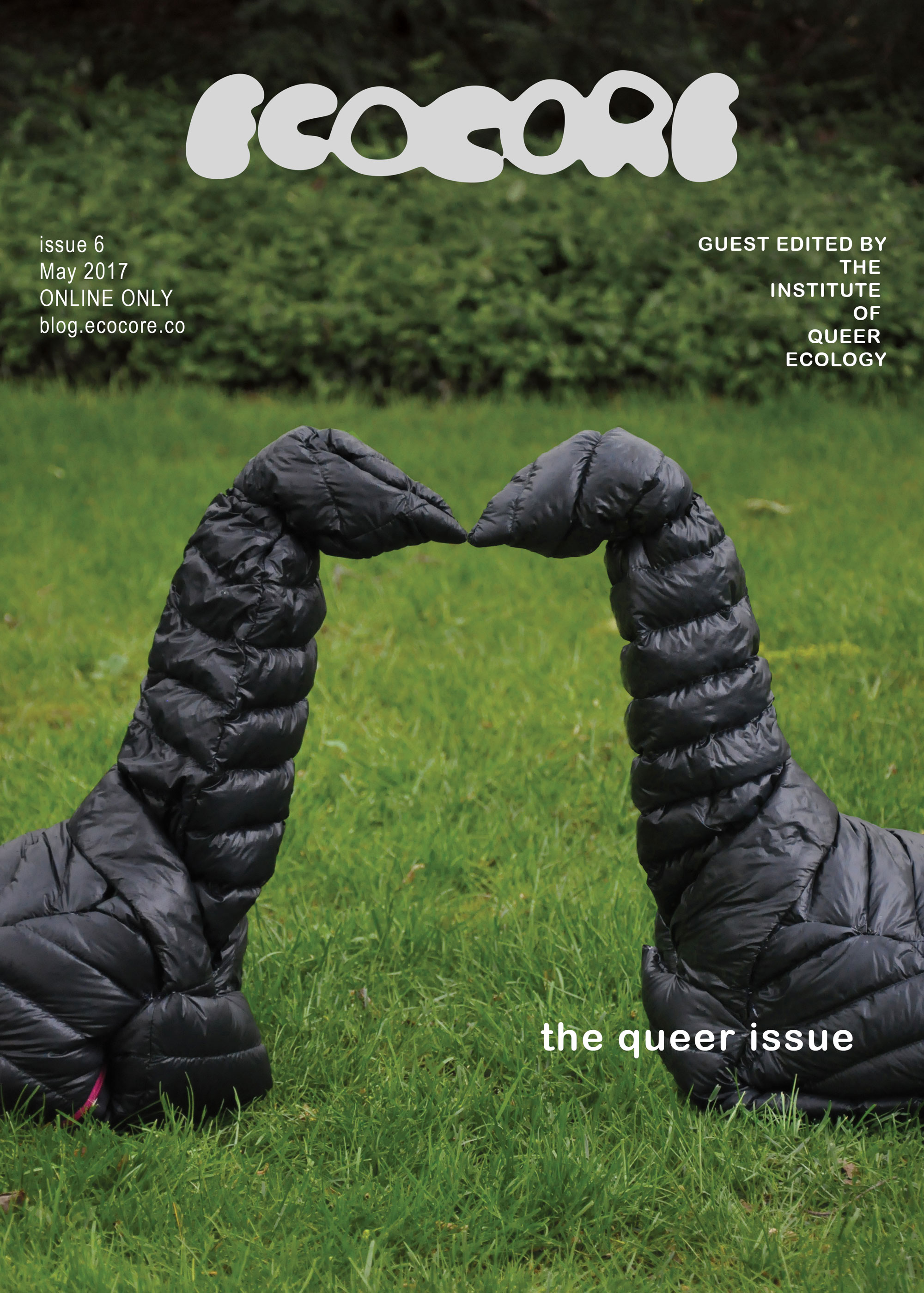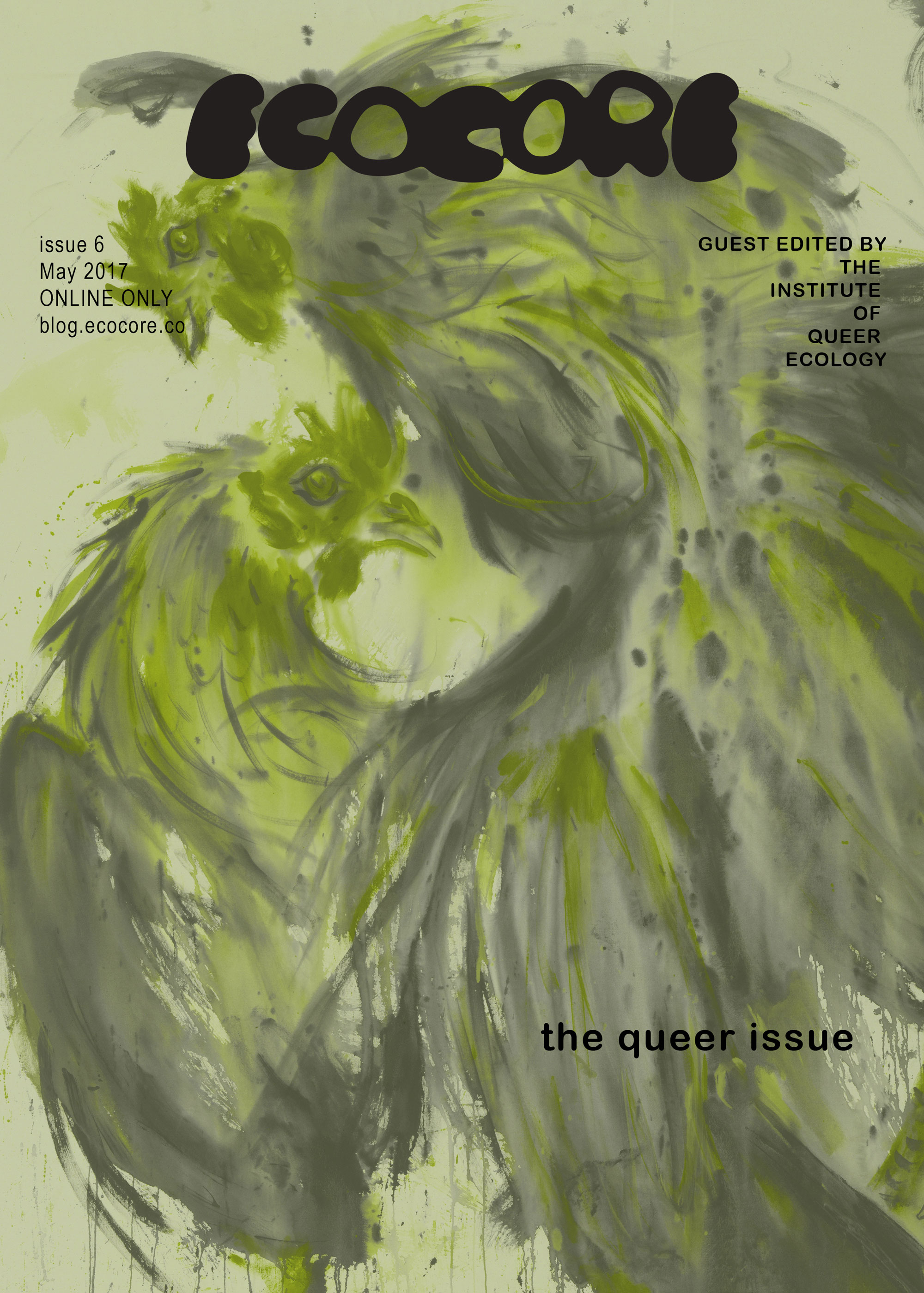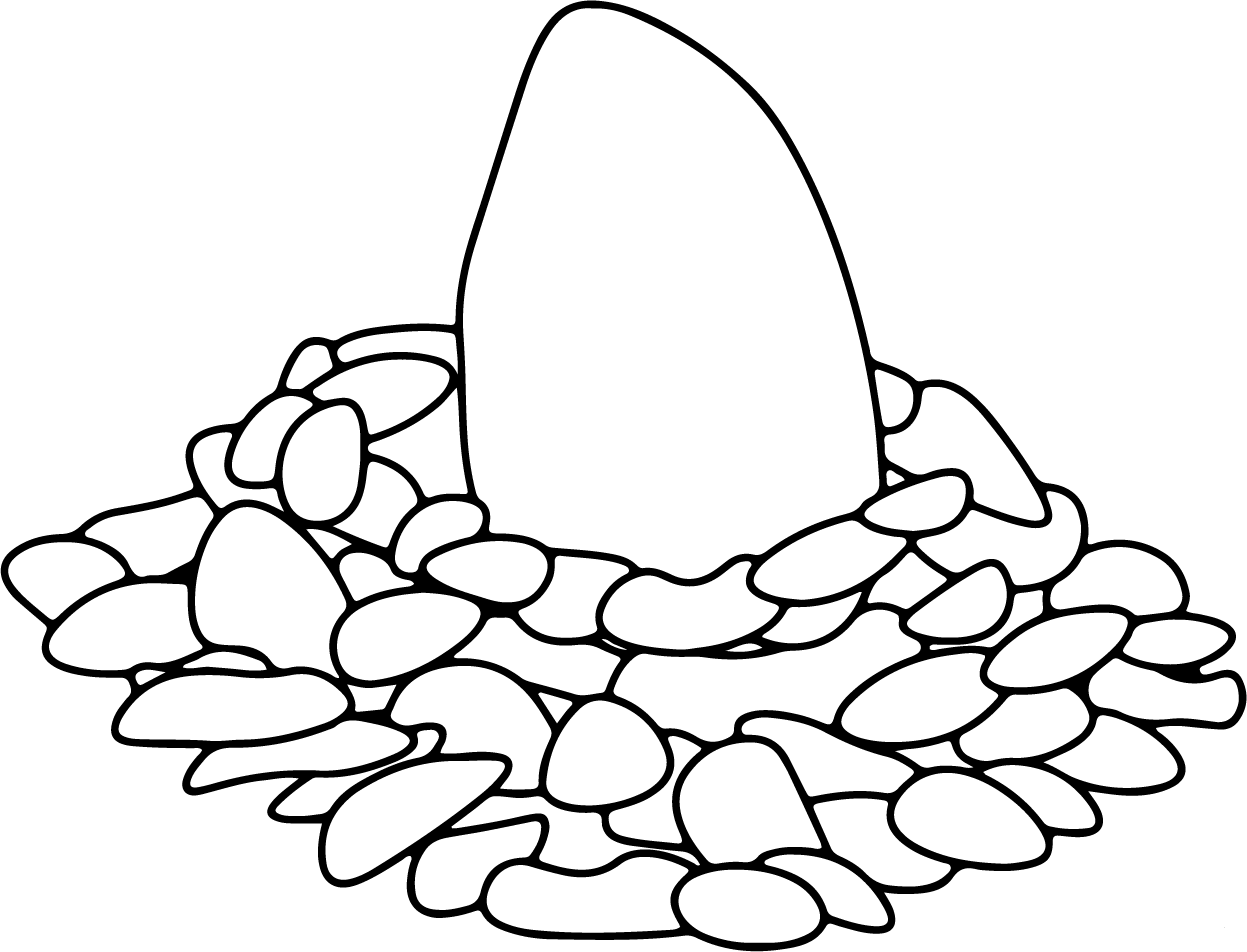
ECOCORE : The Queer Issue
Guest Edited by The Institute of Queer Ecology
Online Publication
2017
**READ ECOCORE: THE QUEER ISSUE HERE**
Bruce Bagemihl
Urban Barnyard
Alessandro Bava
Andrej Dubravsky
Ryan Hammond
Liby Hays
Caspar Heinemann
Alex Ju
Exene Karros
Les U. Knight / VHEMT
Lee Pivnik
Isabella Rossellini
Jack Schneider
Greta Skagerlind
Briohny Walker
Queerness is not yet here. Queerness is an ideality. Put another way, we are not yet queer. We may never touch queerness, but we can feel it as the warm illumination of a horizon imbued with potentiality. We have never been queer, yet queerness exists for us as an ideality that can be distilled from the past and used to imagine a future.
-José Esteban Muñoz,
Cruising Utopia: The Then and There of Queer Futurity
Ecocore’s sixth issue, The Queer Issue, guest edited by The Institute of Queer Ecology (IQECO), operates at the intersection of queer and environmental discourse, with a mission to improve both fields. Each movement, perpetually evolving though not fast enough, benefits from being in conversation with the other.
Yesterday I found myself at one of the last shows of the Ringling Bros. and Barnum & Bailey Circus, in Providence, Rhode Island. I had just left a meeting with two other members of IQECO, where we discussed the types of invisible labor being done by plankton (plus other microbial Foundation Species) and queer (human) communities. When I arrived at the circus, then, I found myself still burdened with criticality.
When the lights went out and spotlights hit a cage in the center of the arena, 12 tigers were sitting on stools and I braced myself for an unnerving show. A large man with dueling whips lashed the tigers, ordering the cats to jump, roar, stand, and move about. I sank lower into my chair, feeling rather microbial as a crowd of thousands clapped and screamed in excitement at the spectacle of human supremacy.
Earlier, as the National Anthem had boomed, a lesbian couple sat down next to me and I let out a sigh of relief. The three of us would form an instant unspoken alliance for the next 3 hours, silently critiquing the The Greatest Show on Earth. So when the 12 tigers began leaping in fear of a man who commanded them and the audience into a frenzy, I looked towards my newfound queer sisters. I was disappointed to see that they too were cheering, hand in hand.

I lay out this anecdote to highlight the dangerous rift still standing between queer and environmental justice. I expected the couple next to me to naturally align themselves with the subjugated tigers, rather than with oppressive man. But as critical conversations about ecology and queerness are still far from the mainstream, this way of thinking takes time and dedication. Eventually, I believe it will prove incredibly helpful for both the lgbt+ community and the natural world. This new alignment allows queer individuals to find kin with any oppressed species, many of which are queerer than we imagined. While tigers have not yet been observed to engage in homosexual behavior, at least another 1,500 species have, including lions, where homosexual and trans individuals have been recorded.
Our simplified collective understanding of human gender and sexuality collapses on itself when we are confronted by a fungus with 28,000 sexes. Catriona Sandilands states (while discussing the works of Elizabeth Wilson and Myra Hird) that “nonhuman sexual and gender diversity both calls into question human exceptionalism and destabilizes notions of identity, authenticity, and technology on which modern categories of human sexual orientation rest.” The research is overwhelming and powerful, as exemplified by the enduring influence of Bruce Bagemihl’s seminal text, Biological Exuberance. Bagemihl’s book about animals with homosexual tendencies was used as evidence by the American Psychiatric Association before the US Supreme Court in Lawrence v. Texas, a case that ultimately struck down sodomy laws in 14 states.
The Queer Issue presents IQECO’s inaugural attempt to present a sliver of this growing body of research, as well as works by artists that consider this hybridized way of thinking. The Queer Issue is assembled eclectically, with republished texts by Bruce Bagemihl that have heavily influenced the field, as well as original commissions for the occasion of this issue. Liby Hays will present a collection of four poems from the perspective of a Trans Termite Queen. Briohny Walker will contribute a new paper on an ethics of failure and futurelessness. Greta Skagerlind invites you to contribute to their ever-growing in-flux definition of Queer Design Principles via a collaborative google doc. Ryan Hammond will talk about their ongoing work, Open Source Gender Codes, which attempts to queer current regimes of pharmaceutical production and systems of ownership by producing open source hormone production protocols.
Ecocore and IQECO welcome you to The Queer Issue.
Edited by Lee Pivnik for the Institute of Queer Ecology

Additionally, we would like to out our non-human contributors. The following is a list of animals that have been recorded exhibiting either homosexual or transgender behavior, assembled by Bagemihl in his 1999 publishing of Biological Exuberance. Their vibrant and diverse existence reminds us with force that we are not alone in our queerness, but should our species continue to encroach on their habitats, we may find ourselves increasingly lonesome.
Acorn Woodpecker
Addax
Antelope
Adelie Penguin
African Buffalo
African Elephant
African jacana
African swallowtail butterfly
Agile Wallaby
akepa
Allen hummingbird
Amazon Molly
Amazon River Dolphin see Boto
American Bison
American kestrel
angelfish
Anna’s Hummingbird
ant
Aoudad
Aperea
arctic tern
Asiatic Elephant
Asiatic Mouflon
Atlantic Spotted Dolphin
Australian noisy miner
Australian raven
Australian Sea Lion
Australian Shelduck
avocet
Aztec Parakeet
badger
Bank Swallow
Barasingha
Barbary Sheep
Barn Owl
barn swallow
bat
bearded seal
beaver
Beluga Bengalese Finch (Domestic)
bewick’s swan
Bezoar
Bharal
Bicolored Antbird
Bighorn Sheep
bird of paradise
black-and-white warbler
Black Bear
Black-billed Magpie
Blackbuck
black-capped chickadee
black-capped lorikeet
Black-crowned Night Heron
Black-footed Rock Wallaby
black-headed grosbeak
Black-headed Gull
Black-rumped Flameback
Black Stilt
Black Swan
Black-tailed Deer
black-tailed gull
black-tailed prairie dog
Black-winged Stilt
Blue-backed Manakin
Blue-bellied Roller
blue-billed duck
bluebird
bluejay
Blue Sheep see Bharal
bluethroat
Blue Tit
Blue-winged Teal
boat-tailed grackle
Bonnet Macaque
Bonobo
Boto
Bottlenose Dolphin
bowerbird
Bowhead Whale
Bridled Dolphin
Brown Bear see Grizzly Bear
brown booby
Brown Capuchin
Brown-headed Cowbird
Brown Long-eared Bat
brown noddy
Brown Rat Budgerigar (Domestic)
Buff-breasted Sandpiper
bufflehead duck
burro
Bush Dog
butterfly
Calfbird
California Gull
California sea lion
Canada Goose canary
Canary-winged Parakeet
Caribou
Caspian Tern
cassowary
Cat (Domestic)
Cattle (Domestic)
Cattle Egret
centipede
Chaffinch
Cheetah
Chicken (Domestic)
Chiloe Wigeon
chimney swift
Chinese water deer
clapper rail
Cliff Swallow
Collared Peccary
Commerson’s Dolphin
Common Brushtail Possum
Common Chimpanzee
Common Dolphin
Common Garter Snake
Common Gull
Common Marmoset
Common Murre
Common Pipistrelle
Common Raccoon
Common Shelduck
Common Tree Shrew
coral goby
cormorant
Costa’s hummingbird
cottontail rabbit
Cotton-top Tamarin
coyote
coypu
Crab-eating Macaque
crane
crane fly
Crane spp.
Crested Black Macaque
crow
Cui
curlew
cutworm
Dall’s Sheep see Thinhorn Sheep
Damaraland mole-rat
Daubenton’s Bat
Dayak fruit bat
Desert Tortoise
dipper
Dog (Domestic)
Doria’s Tree Kangaroo
dragonfly
Dragonfly spp.
Dugong
Dusky Moorhen
Dwarf Cavy
Dwarf Mongoose
eagle earthworm
Eastern Bluebird
Eastern Cottontail Rabbit
Eastern Gray Kangaroo
echidna
Egyptian Goose
eider duck
Eleanora’s falcon
Elegant Parrot Elk see Wapiti
emperor penguin
Emu
Euro
European Bison see Wisent
European jay
European Shag
falcon
Fallow Deer
False Killer Whale
Fat-tailed Dunnart finch
Fin Whale
firefly
fisher
Flamingo
fox
fox squirrel
frog, poisonous
fruit bat
Fruit Fly spp.
fulmar
Galah
garter snake
gecko
Gelada Baboon
Gentoo Penguin
giant cowbird
giant river otter
Giraffe
glaucous-winged gull
Goat (Domestic)
Golden Bishop Bird
golden eagle
golden lion tamarin
Golden Monkey
Golden Plover
Gorilla
Grant’s Gazelle
Gray-breasted Jay
Gray-capped Social Weaver
gray-cheeked mangabey
Gray-headed Flying Fox
Gray Heron
Gray Seal
Gray Squirrel
Gray Whale
great bustard
Great Cormorant
great crested flycatcher
great egret
Greater Bird of Paradise
greater painted-snipe
Greater Rhea
great tit
Green Sandpiper
Greenshank
Greylag
Goose
Griffon Vulture
Grizzly Bear
grouper
grouse
Guianan Cock-of-the-Rock
Guillemot see Common Murre Guinea Pig (Domestic)
Hamadryas Baboon
hamlet Hammerhead
Hamster (Domestic)
Hanuman Langur
Harbor Porpoise
Harbor Seal
hare
Harris’s hawk
Harris’s sparrow
hawk
hawkmoth
hedgehog
heron
Herring Gull
Himalayan Tahr
Hoary-headed Grebe
Hoary Marmot
honeybee
hooded pitohui
Hooded Warbler Horse (Domestic)
house martin
House Sparrow
Humboldt Penguin
humbug damselfish
humpback whale
hyena
Indian Fruit Bat
Indian Muntjac
Indian Rhinoceros
Ivory Gull
jabiru stork
jacana
Jackdaw
jackrabbit
Japanese Macaque
Japanese sea raven
Javan wart snake
Javelina see Collared Peccary
jellyfish
kalanga parrot
Kangaroo Rat
kentish plover
Kestrel
Killer Whale
king bird of paradise
King Penguin
kit (blue) fox
Kittiwake
kiwi
Koala
Kob
lantern bass
lantern fish
Lapland longspur
lapwing
Larga Seal see Spotted Seal
Laughing Gull
Laysan Albatross
Least Chipmunk
Lechwe lemming
lesser black-backed gull
Lesser Bushbaby
Lesser Flamingo
lesser kestrel
Lesser Scaup Duck
lesser yellowlegs
Lion
Lion-tailed Macaque
Lion Tamarin
Little Blue Heron
Little Brown Bat
Little Egret
Livingstone’s Fruit Bat
Long-eared Hedgehog
Long-footed Tree Shrew
Long-legged Fly spp.
long-tailed duck
Long-tailed Hermit Hummingbird
long-tailed manakin
loon
lorikeet
lucifer hummingbird
lunulated antbird
magnificent hummingbird
Mallard Duck
marabou stork
marbled murrelet
Markhor
marmoset
marsupial mouse
Marten sp.
Masked Lovebird
Matschie’s Tree Kangaroo
Mazarine Blue
Mealy Amazon Parrot
Mew Gull see Common Gull
Mexican Jay see Gray— breasted Jay
mink
Mocó
Mohol Galago see Lesser Bushbaby
mole
mole-rat
mole-vole
Monarch Butterfly
monitor lizard
Montagu’s harrier
Moor Macaque
Moose
moth
Mountain Goat
mountain lion
Mountain Tree Shrew
Mountain Zebra
Mule Deer
murre
Mustached Tamarin
mustached warbler
Musk Duck
Musk-ox
Mute Swan
naked mole-rat
natal robin
Natterer’s Bat
New Zealand fur seal
New Zealand Sea Lion
nightjar
Nilgiri Langur
Noctule
North American Porcupine
Northern Elephant Seal
Northern Fur Seal
northern jacana
northern lapwing
Northern Quoll
northern rough-winged swallow
Ocellated Antbird
Ocher-bellied Flycatcher
Olympic Marmot
one-wattled cassowary
opossum
Orange Bishop Bird
Orange-fronted Parakeet
Orang-utan
Orca see Killer Whale
oriole
Ornate Lorikeet
osprey
Ostrich
owl
oyster
